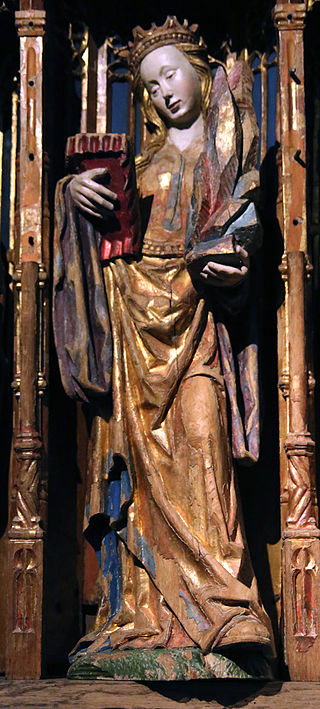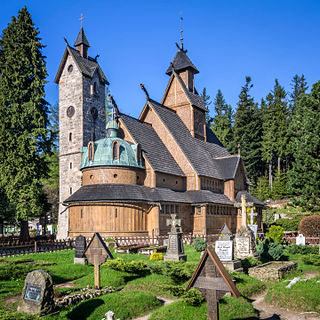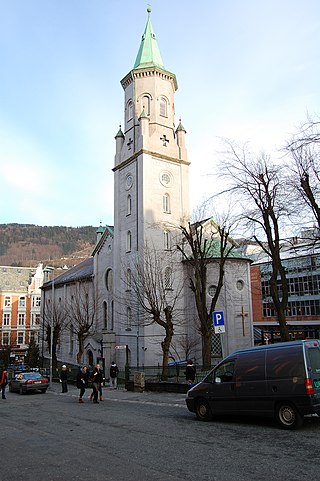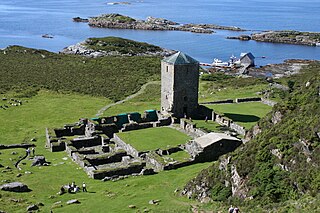
Magnus Olafsson, better known as Magnus the Good, was King of Norway from 1035 and King of Denmark from 1042 until his death in 1047.

Olaf II Haraldsson, also Olav Haraldsson and Olaf the Stout, later known as Saint Olaf and Olaf the Holy, was King of Norway from 1015 to 1028. Son of Harald Grenske, a petty king in Vestfold, Norway, he was posthumously given the title Rex Perpetuus Norvegiae and canonised at Nidaros (Trondheim) by Bishop Grimketel, one year after his death in the Battle of Stiklestad on 29 July 1030. His remains were enshrined in Nidaros Cathedral, built over his burial site. His sainthood encouraged the widespread adoption of Christianity by Scandinavia's Vikings/Norsemen.

Vik is a municipality in Vestland county, Norway. It is located on the southern shore of the Sognefjorden in the traditional district of Sogn. The administrative center of Vik is the village of Vikøyri. Other villages in the municipality include Feios, Fresvik, Nese, and Vangsnes.

Balestrand is a former municipality in Sogn og Fjordane county, Norway. It was located on the northern shore of the Sognefjorden in the traditional district of Sogn. The administrative center was the village of Balestrand. Other villages in the municipality included Ese, Kvamme, Låne, Sæle, Tjugum, and Vetlefjorden.

Selje is a former municipality in the old Sogn og Fjordane county, Norway and was located in the traditional district of Nordfjord. The village of Selje was the administrative center this municipality. and neighborhoods in the municipality included Barmen, Ervik, Flatraket, Hoddevik, Hoddevika, Håvik, and Leikanger. On 1 January 2020 the municipality became part of the new Stad Municipality in the newly formed Vestland county.

Olav Aukrust was a Norwegian poet and teacher. He popularized the use of Nynorsk as a literary language and is most commonly associated with his poem Himmelvarden (1916).

Lom is a municipality in Innlandet county, Norway. It is located in the traditional district of Gudbrandsdal. The administrative centre of the municipality is the village of Fossbergom. Another village area in Lom is Elvesæter.

Grip Stave Church is a historic parish church of the Church of Norway in Kristiansund Municipality in Møre og Romsdal county, Norway. It is located in the now-abandoned fishing village of Grip on the small island of Grip about 14 kilometres (8.7 mi) northwest of the town of Kristiansund. It is an annex church for the Kristiansund parish which is part of the Ytre Nordmøre prosti (deanery) in the Diocese of Møre. The white, wooden church was built in a rectangular stave church style in 1470 by an unknown architect.

Saint Sunniva is the patron saint of the Norwegian Church of Norway Diocese of Bjørgvin, as well as all of Western Norway.

Vang Stave Church or Mountain Church of Our Savior is a stave church located in Karpacz in the Karkonosze mountains in Poland. It was transferred to its present location from Vang in the Valdres region of Norway and re-erected in 1842. A notable tourist attraction, it is Poland's only stave church. It serves as a parish church of the Evangelical Church of the Augsburg Confession in Poland.

Hans Dahl was a Norwegian painter. He was best known for his paintings of Norwegian fjords and surrounding landscapes.

Arnstein Rynning Arneberg was a Norwegian architect. He was active professionally for 50 years and is often considered the leading architect in Norway of his time.

The Catholic Church in Norway is part of the worldwide Catholic Church. As of May 2014, there were over 151,000 registered Catholics in Norway. It is claimed there are many Catholics who are not registered with their personal identification number and who are not reported by the local church; the full number may be as high as 230,000, 70% of whom were born abroad. That constitutes about 5% of the population, making Norway the most Catholic country in Nordic Europe.

Selja Abbey was a Benedictine monastery located on the island of Selja in the municipality of Stad, Vestland, Norway. The island of Selja, which has been formerly known as Sellø or Selø, is located 15 minutes by boat from Selje's mainland.
Olaf Offerdahl was apostolic administrator for Norway from 1928 to March 1930, when he was promoted to apostolic vicar, which he remained until his death later the same year.

Stangvik Church is a parish church of the Church of Norway in Surnadal Municipality in Møre og Romsdal county, Norway. It is located in the village of Stangvik on the shores of the Stangvikfjorden. It is the church for the Stangvik parish which is part of the Indre Nordmøre prosti (deanery) in the Diocese of Møre. The white, wooden church was built in a long church design in 1897 using plans drawn up by the architect Karl Norum and the builder Lars Mogstad. The church seats about 600 people, making it the largest church in Nordmøre.

Balestrand is a village in Sogndal Municipality in Vestland county, Norway. The village is located on the northern shore of the Sognefjorden, at the mouth of the small Esefjorden. It sits about 20 kilometres (12 mi) west of the village area of Leikanger-Hermansverk and about 7 kilometres (4.3 mi) northwest of the village of Vangsnes. The small village of Tjugum lies less than 700 metres (2,300 ft) north of Balestrand, across the Esefjorden. The local Tjugum Church is located there, serving the people of the village of Balestrand.

Hove Church is a historic parish church of the Church of Norway in Vik Municipality in Vestland county, Norway. It is located in the village of Vikøyri on the Arnafjord, an arm of the Sognefjord. It was historically the main church for Hove parish in the Diocese of Bjørgvin. The gray, stone church was built in a long church design in a Romanesque style around the year 1170 using plans drawn up by unknown architect. Since about 2016 the church has been the base for the Hove Church Music Festival run by local cultural personality, Jens Brekke, and an American early music chamber choir. The church seats about 35 people.

Kviknes Hotel is a hotel, located by the Sognefjord in Sogndal Municipality in Vestland county, Norway. The hotel has 195 rooms in total which are divided between two buildings. The historic building was completed in 1913 and has 25 rooms, while the building from the 1960s contains 165 rooms. The hotel is a member of the Norwegian association of historic hotels and restaurants – De historiske.






























